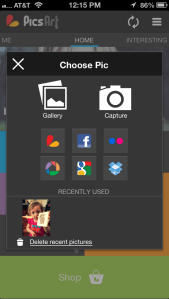PicsArt, a bootstrapped mobile startup which forged its success by going Android-first, is today releasing its mobile photo editing application on Apple’s App Store. Since its launch a little over a year ago, PicsArt has already reached 35 million downloads on Google Play. That’s a fairly significant number, considering that photo-sharing leader Instagram crossed the 50-million mark on Android this past October, for instance.
 In addition, the company tells me that PicsArt today has almost 2 million unique daily users, and is the top application listed in Google Play’s Photography section in all the markets where Google Play is available. It was No. 2 today here in the U.S. (update: it’s now back to No. 1), but these charts fluctuate. Although the app requires no registration before you can use it – allowing users to simply save photos locally or share them on other social networks – 4 million users have registered accounts with PicsArt for sharing within its own community.
In addition, the company tells me that PicsArt today has almost 2 million unique daily users, and is the top application listed in Google Play’s Photography section in all the markets where Google Play is available. It was No. 2 today here in the U.S. (update: it’s now back to No. 1), but these charts fluctuate. Although the app requires no registration before you can use it – allowing users to simply save photos locally or share them on other social networks – 4 million users have registered accounts with PicsArt for sharing within its own community.
On Google Play, PicsArt has garnered over 500,000 reviews, and has an average rating of 4.7. (Instagram is 4.6, for what it’s worth, while competitor Adobe Photoshop Express has a 4.0 rating.)
Users are drawn to PicsArt for its free photo-editing tools, which rival those found in other paid applications. While no good photo editor would be complete without filters these days – and PicsArt has plenty of those – the app is known for its other more advanced editing tools like photo masks, corrections (adding a tan or whitening teeth), frames, and borders, plus the ability to draw on the photo with various brushes and add graphics, clipart, shapes, and more.

It’s somewhat surprising that an app with a more complex feature set has actually done so well on mobile. That’s something that’s not lost on Artavazd Mehrabyan, PicsArt’s co-founder and CTO. “In terms of understanding mobile, [PicsArt is] more like the PC or desktop experience where you have everything in one place,” he explains. That goes against the grain of what typically works on mobile. “It’s much easier to manage an application that is doing one thing than is doing a thousand things,” he says.
The company launched the PicsArt photo editing suite in November 2011, following the release of several other single-purpose apps (which are still live in Google Play). It was a big decision, Mehrabyan says, because at the time users seemed to prefer simpler apps. But the team soon found that PicsArt’s complexity actually made it better. “We were afraid that users would get lost in the amount of functions, but it happens that modern users are adopting and learning and want more and more,” Mehrabyan says. “It’s becoming a place where people discover their creativity.”
The company encourages users’ learning process, too, and even provides several online video tutorials on how to perform specific photo-editing tasks like adding a motion-blur effect, removing red eye, blending, and more.
Mehrabyan tells us that the app’s development has been entirely shaped by crowd-sourcing and by listening to user feedback. Matt Bartelsian, Strategic Marketing at PicsArt, also notes that the app never got a push from Google on its path to 35 million downloads, and it wasn’t featured on any lists. “Up until a few weeks ago, we never even had communication with Google,” Bartelsian tells me. “This app is the people’s app. I know that sounds like cheesy marketing wank, but PicsArt is entirely its own community’s app and people feel like that. They’re the ones that have driven our success. It hasn’t been fantastic marketing, it’s been a fantastic app.”
 PicsArt also supports making photo collages – something which may have contributed to its growing popularity as well, given that Instagram’s user base has pushed collage builders like Pic Stitch to the top of App Store charts. However, PicsArt has avoided supporting Instagram exports in both its Android app and today’s new iOS version, offering export to the camera roll, Facebook, Twitter, Dropbox and email instead. On Android, the app supports more export options, including Picasa, Foursquare, Tumblr, Blogger, WordPress, DeviantArt, and SMS. But now that it’s on iOS, the team is looking into improved support for Instagram.
PicsArt also supports making photo collages – something which may have contributed to its growing popularity as well, given that Instagram’s user base has pushed collage builders like Pic Stitch to the top of App Store charts. However, PicsArt has avoided supporting Instagram exports in both its Android app and today’s new iOS version, offering export to the camera roll, Facebook, Twitter, Dropbox and email instead. On Android, the app supports more export options, including Picasa, Foursquare, Tumblr, Blogger, WordPress, DeviantArt, and SMS. But now that it’s on iOS, the team is looking into improved support for Instagram.
Today’s iOS release has around 90 percent of the Android’s app features, and the rest will be added soon. In addition, the team is working on tablet support and support for higher-resolution photos.
But perhaps the most remarkable thing about PicsArt’s story, however, is not the sum of its features, but that it has grown to profitability through in-app ads with little marketing and no outside funding. The bootstrapped company has a team of 20 to 25 based in Armenia, and just over half a dozen more located elsewhere, including a few in offices in Mountain View, Calif.
“We’re profitable and we’ve just launched into the iOS space,” says Bartelsian. “We’re happy with our revenue and we’ve got a model that’s working. Any thought of selling out, or VCs, or external funding is not a relevant discussion right now. ”
PicsArt for iOS is available for download here.
